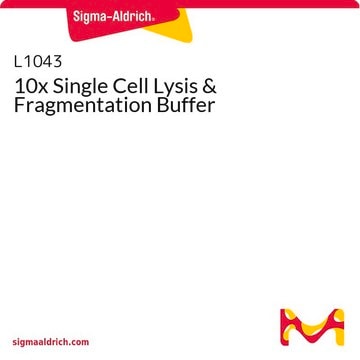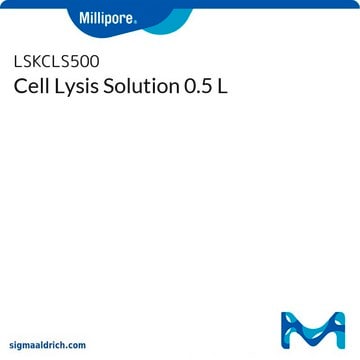C3228
CelLytic™ MT Cell Lysis Reagent
For mammalian tissues
Synonym(s):
Cell lysis buffer, Cell lysis reagent
Sign Into View Organizational & Contract Pricing
All Photos(1)
About This Item
UNSPSC Code:
41116134
NACRES:
NA.56
Recommended Products
Quality Level
form
solution
Application
CelLytic™ MT Cell Lysis Reagent has been used in the homogenization of hippocampi tissues, quadriceps muscles from mice, primary human trophoblasts (PHT), soleus muscles from mice and organs of Corti (OCs).
Features and Benefits
- Gentle: Non-denaturing and does not interfere with downstream applications
- Convenient: Provided ready to use
Other Notes
CelLytic MT is an efficient reagent for the extraction of proteins. The lysis buffer consists of a dialyzable mild detergent, bicine, and 150 mM NaCl, resulting in minimal interference with protein interactions and biological activity. CelLytic MT is also used for extraction of cell-line proteins. A volume of 20 mL of CelLytic MT is sufficient for 1 gram of tissue.
Quality
It has been tested, but not limited to the following tissues: rat brain, kidney, muscle, heart, liver, spleen and mouse brain, kidney and muscle.
Legal Information
CelLytic is a trademark of Sigma-Aldrich Co. LLC
related product
Product No.
Description
Pricing
Storage Class Code
10 - Combustible liquids
WGK
WGK 2
Flash Point(F)
Not applicable
Flash Point(C)
Not applicable
Certificates of Analysis (COA)
Search for Certificates of Analysis (COA) by entering the products Lot/Batch Number. Lot and Batch Numbers can be found on a product’s label following the words ‘Lot’ or ‘Batch’.
Already Own This Product?
Find documentation for the products that you have recently purchased in the Document Library.
Customers Also Viewed
Aerobic exercise, but not metformin, prevents reduction of muscular performance by AMPk activation in mice on doxorubicin chemotherapy
de Lima EA, et al.
Journal of Cellular Physiology, 233(12), 96529662-96529662 (2018)
Pasireotide protects mammalian cochlear hair cells from gentamicin ototoxicity by activating the PI3KAkt pathway
Kucharava K, et al.
Cell death & disease, 10(2), 110-110 (2019)
Terry D Hinds et al.
The Journal of biological chemistry, 291(48), 25179-25191 (2016-10-21)
Non-alcoholic fatty liver disease is the most rapidly growing form of liver disease and if left untreated can result in non-alcoholic steatohepatitis, ultimately resulting in liver cirrhosis and failure. Biliverdin reductase A (BVRA) is a multifunctioning protein primarily responsible for
Joseph S Marino et al.
The Journal of biological chemistry, 291(50), 25776-25788 (2016-10-28)
Glucocorticoids (GCs) regulate energy supply in response to stress by increasing hepatic gluconeogenesis during fasting. Long-term GC treatment induces hepatic steatosis and weight gain. GC signaling is coordinated via the GC receptor (GR) GRα, as the GRβ isoform lacks a
Mechanistic Target of Rapamycin Complex 1 Promotes the Expression of Genes Encoding Electron Transport Chain Proteins and Stimulates Oxidative Phosphorylation in Primary Human Trophoblast Cells by Regulating Mitochondrial Biogenesis
Rosario FJ, et al.
Scientific Reports, 9(1), 246-246 (2019)
Our team of scientists has experience in all areas of research including Life Science, Material Science, Chemical Synthesis, Chromatography, Analytical and many others.
Contact Technical Service










